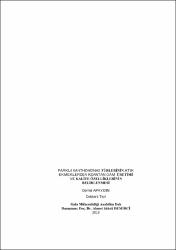| dc.contributor.author | Apaydın, Demet | |
| dc.date.accessioned | 2020-01-27T11:59:10Z | |
| dc.date.available | 2020-01-27T11:59:10Z | |
| dc.date.issued | 2019 | |
| dc.identifier.uri | https://hdl.handle.net/20.500.11776/3473 | |
| dc.description.abstract | Bu araştırmada gıda atıklarının önemli bir kısmını oluşturan atık ekmeklerin ekonomik olarak değerlendirilmesi amacıyla atık ekmeklerden farklı Xanthomonas izolatları ve standart üretici izolatı ile optimum koşullarda ksantan gam üretilmesi ve elde edilen gamların reolojik, teknolojik özellikleri, kimyasal kompozisyonu ve model gıdalarda kullanım olanakları araştırılmıştır. Ekmek hidrolizatı seyreltilerek ksantan gam fermentasyonunda tek karbon kaynağı olarak kullanılmış, böylece yüksek verimde ksantan gam üretimi gerçekleştirilmiştir. Fermentasyon boyunca, besiyerindeki glukoz azaldıkça biyokütle ve polimer üretimi artış göstermiştir. Kantan gam üretimleri ise genel olarak 72. saatte maksimum seviyelere ulaşmış ve fermentasyon sonuna kadar aynı seviyelerde kalmıştır. X. hortorum pv. pelargonii, X. axonoopodis pv. begoniae, X. axonopodis pv. vesicatoria ve X. campestris DSM 19000 için optimum ksantan gam verimi sırasıyla 12,5 gL-1, 10,3 gL-1, 14,3 gL-1 ve 12,9 gL-1 olarak tespit edilmiştir. Atık ekmek substratında X. campestris DSM 19000 tarafından üretilen gamların sulu çözeltileri en iyi viskozite özelliği gösterirken, izolatların ürettiği gamların model gıdada daha iyi kıvam verdiği belirlenmiştir. En yüksek viskozite X. campestris DSM 19000 tarafından üretilen gamların %2 konsantrasyonunda 10,57 Pa.sn olarak belirlenmiştir. Model gıda olarak üretilen pudingte X. hortorum pv. pelargonii ve X. axonopodis pv. begoniae tarafından üretilen gam daha iyi viskozite sağlamıştır. Üretilen bütün gamların ksantan gamın tipik monomerleri olan glukoz, mannoz ve glukuronik asit içerdiği ve bu açıdan ticari gam ile benzerlik gösterdiği belirlenmiştir. Gamların glukoz içerikleri %19,88-31,67 arasında, mannoz içerikleri 2,90-6,71 arasında, pirüvik asit içerikleri %2,17-%4,82 arasında, asetik asit içerikleri %3,45-%7,61 arasında ve ortalama moleküler ağırlıkları ise 1,41x106-1,76x106 g/mol arasında belirlenmiştir. Pirüvik asit içeriği ve moleküler ağırlık artışının viskozitenin gelişimi ile bağlantılı olduğu tespit edilmiştir. Sonuç olarak; tez çalışmasında kullanılan izolatlar içerisinde atık ekmeklerden gam üretim miktarı açısından en iyi bakteri X. axonopodis pv. vesicatoria olurken, gam kalite özellikleri açısından X. axonopodis pv. begoniae ön plana çıkmıştır. Ayrıca elde edilen sonuçlar atık ekmeklerin, düşük maliyetli ve verimli ksantan üretimi için güçlü potansiyeli ve umut veren özellikleri olduğunu göstermektedir. Bu yüzden atık ekmeklerden üretilen ksantan gam, endüstriyel ve ticari uygulamalar için güçlü bir aday olarak değerlendirilebilir | en_US |
| dc.description.abstract | In this study, in order to economically utilize from waste breads constituting a significant part of food waste, xanthan gums were produced under optimum conditions with different Xanthomonas isolates and standard producer strain from waste breads, and the rheological, technological properties, chemical composition and utilization possibilities of the obtained gums were investigated. Bread hydrolyzate was diluted and used as the sole carbon source in the xanthan gum fermentation. By using waste bread as a substrate, high efficiency xanthan gum production has been achieved. During fermentation, biomass and polymer production were increased as glucose was decreased in the medium. Xanthan gum production reached maximum levels at 72 hours and remained at the same levels until the end of fermentation. Optimum yields were detected as 12.5 gL-1, 10.3 gL-1, 14.3 gL-1 and 12.9 gL-1 for X. hortorum pv. pelargonii, X. axonoopodis pv. begoniae, X. axonopodis pv. vesicatoria, X. campestris DSM 19000, respectively. While the aqueous solutions of the gums produced by X. campestris DSM 19000 showed the highest viscosity, it was determined that the gums produced by the isolates gave better consistency to the model foods. The highest consistency of aqueous solutions was obtained by gum from standard bacteria with 10.57 Pa.sn at 2% concentration. For instance X. hortorum pv. pelargonii and X. axonopodis pv. begoniae in pudding sample provide better viscosities. It was determined that all the produced gums contain glucose, mannose and glucuronic acid, which are typical monomers of xanthan gum, and show similarity with commercial xanthan gum in this respect. Glucose contents of the gums were changed between 19.88 and 33.60%, while mannose ranged from 2.90 to 6.71%. The pyruvate contents of the gums ranged from 2.17% to 4.82%, the acetic acid contents varied from 3.45% to 7.61% and the average molecular weights ranged from 1.41x106 to 1.76x106 g/mol, with the pyruvate content and molecular weight increase being related to the development of viscosity. As a result; among the isolates used in the study, the best bacteria in terms of amount of gum production from waste breads was X. axonopodis pv. vesicatoria, however, in terms of gum rheological properties X. axonopodis pv. begonia is in the foreground. In addition, the results obtained in our study show that waste breads are potent and promising properties for low cost and efficient xanthan production. Therefore, it can be regarded as a strong candidate for industrial and commercial applications. Key words: Waste bread, xanthan gum, Xanthomonas, rheology | en_US |
| dc.language.iso | tur | en_US |
| dc.publisher | Namık Kemal Üniversitesi | en_US |
| dc.rights | info:eu-repo/semantics/openAccess | en_US |
| dc.subject | Atık ekmek | en_US |
| dc.subject | ksantan gam | en_US |
| dc.subject | Xanthomonas | en_US |
| dc.subject | reoloji | en_US |
| dc.subject | Waste bread | en_US |
| dc.subject | xanthan gum | en_US |
| dc.subject | Xanthomonas | en_US |
| dc.subject | rheology | en_US |
| dc.title | Farklı xanthomonas türlerinin atok ekmeklerden ksantan gam üretimi ve kalite özelliklerinin belirlenmesi | en_US |
| dc.title.alternative | FARKLI XANTHOMONAS TÜRLERĠNĠN ATIK EKMEKLERDEN KSANTAN GAM ÜRETĠMĠ VE KALĠTE ÖZELLĠKLERĠNĠN BELĠRLENMESĠ | en_US |
| dc.type | doctoralThesis | en_US |
| dc.department | Enstitüler, Fen Bilimleri Enstitüsü, Gıda Mühendisliği Ana Bilim Dalı | en_US |
| dc.relation.publicationcategory | Tez | en_US |



















